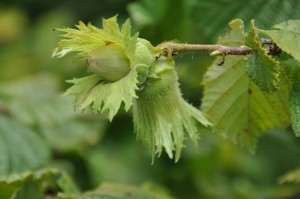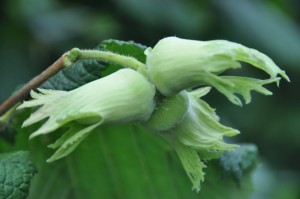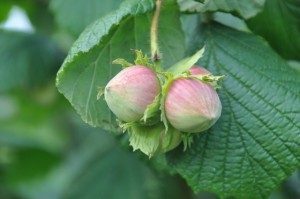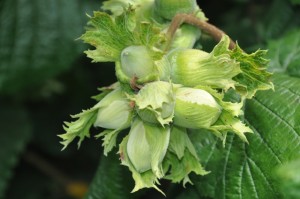22nd August would have been a good day to head south, sorry left, down the A12 toward the M25, and on to Kent. Why? St Philibert’s (Fllbert’s) day, of course. Although he lived around 600 AD in France, he may be the reason we have the White, the Purple and the Frizzled Filbert, just some of the cultivated Corylus. The 22nd was traditionally the day when Cobs and Filberts were ready to harvest. On the other hand, it may have nothing to do with this Gascon Abbot. Filbert may merely be a derivation of “Full beard” in reference to the involucre (husk) of the filbert that entirely encapsulates the nut. That’s the wonderful thing with plant names; we may never be certain of their origin.
So what about the ‘Cob’, being the cultivated variety of C. avellana? The Filberts are said to come from Corylus
maxima.) It was believed that children played an early version of ‘conkers’ with hazelnuts; the game was called cobnut or cobblenut, and the winning nut was crowned “the cob”.
A small group from STOG (Suffolk Traditional Orchards Group) recently made this trip south of London to a beautiful garden, perched on the edge of the Kentish Weald. Meg, our host, treated us to tea and cake, and fruit leather (brought by one of the Suffolk lot), before we headed into the shade of the first Plat(t). These traditional nut orchards are dominated by the “Kentish Cob” but there must be
several hundred different varieties of Cob and Filbert, many being preserved in a collection at the largest commercial Plat we visited.
There are not many days in a life when one can stand on a sunny hillside with a bunch of strangers discussing the identification of a variety based upon the length and frizzleyness of the beard, and the size and shape of its nuts!! We learnt a whole new vocab, including
“brutting”, or was it “bratting” – being the partial snapping off of young branches to encourage more nut growth in the following year.
With new terminology and a renewed enthusiasm for hazels, it was back to Suffolk to protect my own!!
In late August, early September, many of us will have experienced the joy of successfully trawling the hedgerows for blackberry, bullace, sloes, damsons and possibly even the odd crab (apple). Some will have gone a step further in order to make various preserves from Haws, Hips and Rowen berry; and still further, those who start to delve into the hedge bottom for the likes of burdock and radish root. The wild feast is at its most productive now. And of
course do not forget the fungi foragers, who should be out in force following the recent rain.
However, I doubt many of us have had the delight of finding hazelnuts still hanging and ready to eat. Nutkin’s American cousin will have beaten us to it, and don’t be fooled if you see what appears as an unopened nut on the ground, it is almost certainly empty. Sciurus carolinensis has already weighed it up and discarded it. What’s worse, he doesn’t bother to wait for the nut to
form properly, which would give us bipedal foragers a fighting chance, but rather removes the embryo nut when it is no bigger than a pinhead. And conservationists wonder why dormice are struggling to survive!
Following 3 years of concerted efforts to control the grey at Broxtead, we are finally rewarded by adding real wild hazel to the basket, something I have not done in at least 25 years. The taste of green hazelnuts is remarkably similar to that of the early summer taste of the pignut, dug up in the nearby meadows. 2013 will be remembered for the joy of finding something again after such a long abstinence.







